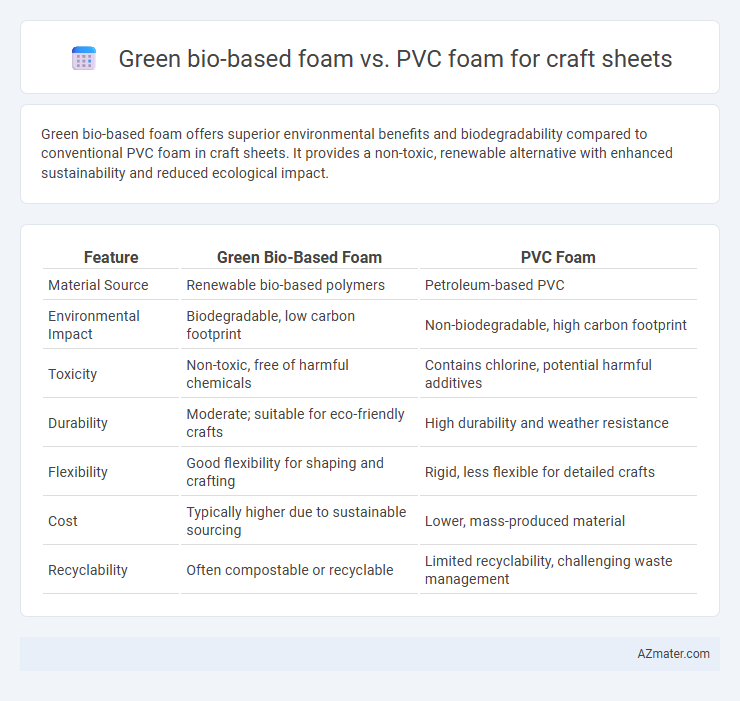Green bio-based foam offers superior environmental benefits and biodegradability compared to conventional PVC foam in craft sheets. It provides a non-toxic, renewable alternative with enhanced sustainability and reduced ecological impact.
Table of Comparison
| Feature | Green Bio-Based Foam | PVC Foam |
|---|---|---|
| Material Source | Renewable bio-based polymers | Petroleum-based PVC |
| Environmental Impact | Biodegradable, low carbon footprint | Non-biodegradable, high carbon footprint |
| Toxicity | Non-toxic, free of harmful chemicals | Contains chlorine, potential harmful additives |
| Durability | Moderate; suitable for eco-friendly crafts | High durability and weather resistance |
| Flexibility | Good flexibility for shaping and crafting | Rigid, less flexible for detailed crafts |
| Cost | Typically higher due to sustainable sourcing | Lower, mass-produced material |
| Recyclability | Often compostable or recyclable | Limited recyclability, challenging waste management |
Introduction to Craft Sheet Materials
Green bio-based foam presents an eco-friendly alternative to traditional PVC foam in craft sheet materials, offering enhanced sustainability through renewable resources and reduced environmental impact. Unlike PVC foam, which is derived from petroleum and associated with toxic chlorine compounds, bio-based foam uses natural polymers such as starch or cellulose, promoting biodegradability and non-toxicity. This shift in raw materials not only supports greener manufacturing practices but also meets increasing consumer demand for safer, recyclable craft supplies.
What is Green Bio-Based Foam?
Green bio-based foam is an eco-friendly alternative to conventional foams, made primarily from renewable biological sources such as plant oils and starches, reducing reliance on petroleum-based materials. This sustainable foam offers comparable durability, flexibility, and lightweight properties essential for craft sheets, promoting environmental responsibility without compromising performance. It biodegrades more readily than PVC foam, making it a preferred choice in industries seeking greener, non-toxic materials.
Overview of PVC Foam in Crafting
PVC foam in crafting offers a durable, lightweight material favored for its rigidity and ease of cutting, making it ideal for detailed models and signage. Its closed-cell structure ensures water resistance and dimensional stability, enhancing the longevity of craft projects exposed to moisture or stress. Despite environmental concerns, PVC foam remains popular due to its affordable cost and versatility in various crafting applications.
Environmental Impact: Bio-Based vs PVC Foam
Green bio-based foam significantly reduces environmental impact by utilizing renewable resources and offering enhanced biodegradability compared to traditional PVC foam, which relies on fossil fuels and generates toxic emissions during production and disposal. Bio-based foams typically exhibit lower carbon footprints and emit fewer volatile organic compounds (VOCs), contributing to improved indoor air quality and reduced environmental pollution. PVC foam's persistence in landfills and challenges in recycling further exacerbate environmental concerns, making bio-based alternatives a more sustainable choice for craft sheet applications.
Physical Properties Comparison
Green bio-based foam exhibits superior environmental sustainability with comparable density and compressive strength to PVC foam, making it a viable alternative for craft sheets. It has enhanced flexibility and lower thermal conductivity, contributing to improved insulation and durability in artistic applications. The mechanical resilience of bio-based foam ensures effective resistance to deformation and impact, surpassing PVC foam's tendency to degrade under prolonged stress.
Safety and Health Considerations
Green bio-based foam for craft sheets offers superior safety and health benefits compared to PVC foam, as it is derived from renewable resources and contains no harmful additives like phthalates or chlorine. Unlike PVC foam, which can release toxic fumes such as dioxins during manufacturing or disposal, bio-based foam exhibits lower emissions and is biodegradable, reducing environmental and human health risks. This makes green bio-based foam a safer alternative for consumers, especially in applications involving prolonged skin contact or indoor use.
Cost Efficiency and Market Availability
Green bio-based foam offers superior cost efficiency compared to PVC foam due to lower raw material expenses and reduced environmental compliance costs, making it an attractive option for craft sheet manufacturers. Market availability of green bio-based foam is expanding rapidly as sustainable materials gain consumer demand and regulatory support, while PVC foam remains widely accessible but faces increasing restrictions due to environmental concerns. The growing adoption of bio-based foams in the craft industry reflects a shift towards cost-effective, eco-friendly alternatives that balance performance with sustainability.
Performance in Craft Applications
Green bio-based foam exhibits superior flexibility and cushioning compared to PVC foam, enhancing its suitability for various craft applications that require lightweight and durable materials. Its biodegradability and non-toxicity make it safer and more environmentally friendly without compromising strength and resilience. PVC foam offers rigidity and water resistance but often lacks the eco-friendly attributes and adaptability found in bio-based alternatives, making green foam preferable for sustainable crafting projects.
Sustainability and End-of-Life Recycling
Green bio-based foam, derived from renewable resources such as plant-based materials, offers superior sustainability compared to traditional PVC foam by significantly reducing carbon footprint and reliance on fossil fuels. Its biodegradability and compatibility with industrial composting systems enhance end-of-life recycling options, allowing for a more circular lifecycle in craft sheet applications. In contrast, PVC foam presents challenges in recycling due to chlorine content and toxic additives, leading to limited recycling infrastructure and increased environmental persistence.
Future Trends in Craft Sheet Materials
Green bio-based foam is gaining traction in craft sheet materials due to its sustainable sourcing, biodegradability, and lower carbon footprint compared to conventional PVC foam. Innovations in bio-polymer formulations and enhanced mechanical properties position bio-based foams as the preferred choice for eco-conscious consumers and manufacturers aiming to meet stringent environmental regulations. Market forecasts indicate a significant shift towards green bio-based foams, driven by increased demand for non-toxic, recyclable, and renewable craft sheet materials in art, design, and educational applications.

Infographic: Green bio-based foam vs PVC foam for Craft sheet
 azmater.com
azmater.com